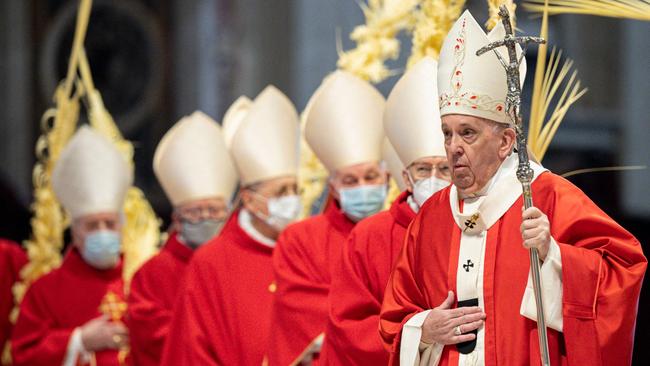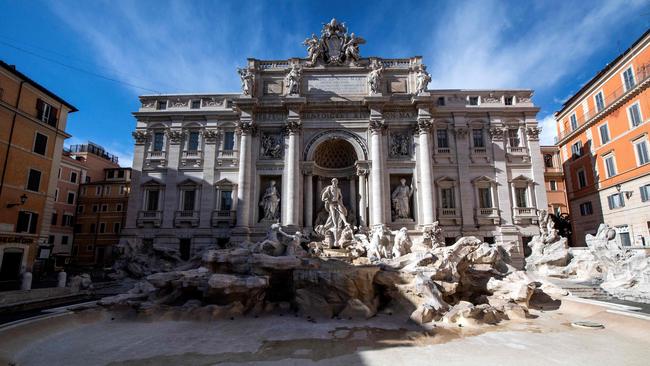Reflection and belief in the quiet Eternal City

The elevated walkway has been used by at least three popes as an escape route; by the notorious Borgia pope Alexander VI in 1494 when the French were advancing on Rome, then in 1527 by Clement VII while fleeing the Germans, and by Pius IX in 1870 when the French troops left the Papal States.
The Eternal City is a ghost town as tourists and pilgrims have vanished. It is a perfect setting for obligatory Lenten penances. A third wave of infections has swept the country so that more than 3.5 million Italians have been infected and 110,000 have died, much worse than in Australia. The school closures are keenly felt and two weeks before Easter there were protests in 23 cities against the lockouts.
Nearly everyone in the Vatican has been vaccinated but the rollout in Italy is slow, as it is across the continent, while Britain’s program is steaming ahead. It is fascinating to see the obstacles created and the prejudices against the Oxford-AstraZeneca vaccine, which is cheap and easily stored.
Italy has a new national government, the 66th since World War II, to meet the crisis and the Premier and many ministers are not elected members of parliament. The national debt is enormous, but for the immediate future of the EU Italy is too big to fail, with a larger economy than both Spain and Greece. Sensibly, Italy has at least a couple of government-sponsored television stations to reflect the different points of view, which is an option that should be considered by any national conservative government in Australia, where the ABC is dominated by a Gramscian hegemony hostile to social conservatives, most Christians and often to Western civilisation. The Italian media is divided and disputatious but not monochrome.
In these COVID times Catholic Rome is also ill at ease, as the Vatican’s financial troubles begin to bite, with the cardinals’ salaries being clipped by 10 per cent and other staff by 8 per cent. Individual masses have been banned on the side altars at St Peter’s Basilica; stopped, probably for the first time since Charles V’s German Protestant troops sacked Rome in 1527.
On a happier note on a sad theme, the increased number of homeless living around the Vatican, sometimes in the colonnades, are well looked after, fed, able to take a shower, and supported by the Pope’s almoner, young Polish Cardinal Konrad Krajewski, with a hands-on approach and a heart of gold. He himself was able to restore the electricity supply of one of his friends when it was interrupted. Many of the younger cardinals have more colourful backgrounds than the old hands.
Most of the poor and all of the taxi drivers in Rome have a viewpoint on religion and the Vatican, while everyone knows when Lent is ending, Holy Week is approaching and has a rudimentary grasp of Christian claims. The Easter bunny doesn’t get much of a run in Rome; thanks be to God.
In Australia, everyone enjoys the Easter break, as they enjoy the Queen’s Birthday holiday, but many haven’t much of a notion about the Christian origins of the celebration, even of Good Friday.
This is partly because the Christian teachings about Easter are quite uncompromising; an explicit claim to supernatural happenings, to the triumph of good over evil through the redemptive suffering and death of the Son of God, despite the reality of so much continuing suffering in the world. Christians claim that in his dying Christ went through to the highest heavens, absolving the faults of many. He looked evil in the eye and defeated it through his own defeat. A large claim.

Christians believe in redemptive suffering, that our personal sufferings can be turned to a good purpose through Christ. This belief can be a wonderful consolation in bad times. I like to recount the anecdote about Karl Marx who, when he had a bad attack of boils, lamented that he did not have a God to whom he could offer his sufferings. At least he knew what he was missing.
Christians claim not only that God continues to work through history, but redemption was achieved through actual events in Jerusalem when Pontius Pilate was the Roman governor and Herod was tetrarch. Christ died on Calvary. Few dispute this. Is he truly risen from the dead? There were no bones in the tomb after the resurrection, only a miraculous liberation, more marvellous even than the Jewish escape from Egypt under Moses. Such might be mistaken claims but they are not a bloodless myth, not an attractive apparition from the dreamtime, but an assertion that the cross has triumphed through the execution of an uneducated preacher, a non-Roman who was crucified like a slave in a difficult outlier province of the empire.
Naturally my words are spoken with a disciple’s tongue and an increasing percentage of Australians, often people of goodwill, cannot accept that they are true; or do not even know what is claimed. Some aren’t interested, others would like to believe but they cannot. I am blessed, or lucky, to have been brought up to believe that this account of God’s love at work is true and I have explicitly chosen to continue to believe. I suspect most Christians at some stage are tempted to wobble, to wonder about the truth, perhaps even to doubt, although the great 19th-century English thinker St John Henry Newman explained that difficulties do not necessarily lead to doubts. But too many are lapsing into disinterest or unbelief. Unfortunately, the sad little story of two clergy, sliding towards agnosticism and discussing theology, does not belong entirely in the realms of fantasy.
“Did you hear,” said the first speaker, “that Jesus’ bones have been found?” “What,” replied his friend, “are you saying that Jesus really existed?” I think we can safely assume that neither of these fictional figures would believe that eternal consequences might follow from the morality or immorality of our actions. Unlike the pagan gods of Greek and Rome, the Judaeo-Christian God is interested in how we live.
Easter is harder to swallow than Christmas, as it is harder to believe that God’s Son suffered and died, than it is to believe that a messenger of God came to live among us to provide moral support. The big difficulty for the Christian case comes from the scriptural evidence because Jesus cannot be portrayed as a good bloke, not even as a good commonsense fellow. His claims are too bizarre.
As CS Lewis rightly concluded from the evidence, Jesus was either a liar, or a lunatic, or the Son of God; or the evidence is completely untrustworthy. From whatever starting point we come to Easter, the author of the beatitudes, of the parables was a religious genius. It is almost beyond dispute that he came to a bad end, was condemned unjustly. Why would his mythmakers burden such an attractive figure with claims that after three days in the grave he rose from the dead; and in that three-day interval, “descended into hell” to liberate the souls of the just who had died earlier? From most points of view the story does not add up.
But the story is coherent for believers and Easter will be celebrated with faith and reverence in all the Christian denominations. Many Catholic churches will have a congregation two or three times bigger than the usual Sunday community.
Most Italians are Catholic or ex-Catholics, with a significant dose of hostility as unbelief is spreading, especially in large cities. But the culture cannot escape its Catholic history. The Pope is the most important person in Italy and, although Pope Francis will celebrate with his cardinals in an almost empty St Peter’s, the church is everywhere with its parishes, monasteries, nuns and friars in their medieval robes.
Italian society with a higher percentage of believers does Easter better than we do in Australia. Italy has no Stawell Gift, no Easter horseracing carnivals, although the soccer has AFL levels of popular support. A cynic once claimed to me that more Italians, especially perhaps in the south, believed that Jesus suffered and died than believe in the resurrection. But in the villages after the Good Friday ceremonies, the procession of the dead Jesus will wind through the streets with Jesus and his mother going to different places to await the resurrection.
In my first Easter as a priest in 1967 in the mountains of Abruzzo, I was performing my ablutions on Easter Sunday morning when a series of loud explosions rocked the village. Were the Vietcong mounting an attack? It was only the locals exploding powerful fireworks to celebrate Jesus’ comeback, his return from the dead.



Easter comes at the correct time of year in the northern hemisphere as spring produces new life. The cherry blossom is out in our piazza and on the streets of Rome, and small green shoots are beginning to appear on the branches of the large western plane trees that run alongside the Leonine walls first constructed by Pope Leo IV in 850 after Rome had been ravaged by the Muslim Saracens. The wall was heightened in 1277-80 by Pope Nicholas III and a walkway constructed linking the Vatican to the fortress Castel Sant’Angelo, which had started out as a colossal mausoleum for the great Emperor Hadrian and his family in AD128.